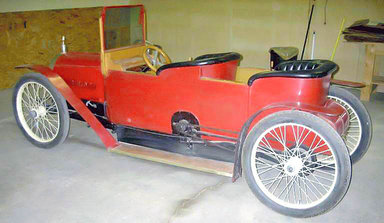Cyclecar

Cyclecars were small, generally inexpensive cars manufactured mainly between 1910 and 1923.
General description
Cycelcars were propelled by single cylinder, V-twin or four cylinder engines, sometimes motorcycle engines. Several motorcycle derivated components were used. Cyclecars were half way between motorcycles and cars, some historians say. Bodies were light bodies, sometimes in tandem two seater configuration. They used various layouts and means of transmitting the engine power to the wheels such as belt drive or chain drive.
Some cyclecars were primitive and offered minimal comfort.
The rise of cyclecars was a direct result of taxation for the registration on cars, because taxation was based on displacement of the engine and weight of the car.
The cyclecars appear
From 1898 to 1910, automobile production quicky expanded. Light cars of that era were commonly known as voiturettes. Cyclecars appeared around 1910. The cyclecar boom began shortly before the outbreak of World War I. The first successful cyclecars were Bédélia of France and G.N. from Britain.
Sporting cars and cyclecar races
There were sporting cyclecars such as Amilcar, Major or Salmson of France.
There were also races dedicated for cyclecars. The first event of this kind was organised by Automobile Club de France in 1913. Memories preserve the Cyclecar GP at Le Mans in 1920. Until the late 1920's, there were races for cyclecars and voiturettes.
The decline of cyclecars
By the early 1920's the days of the cyclecar were numbered. Mass producers, such as Ford, were the extremely successful competitors. The answer of Henry Ford to cyclecars was simple: he introduced a scaled down Model T to keep the price of new Model T cars closer to the price of cyclecars. Affordable cars were offered even in Europe such as Citroën, Austin 7 or Morris Cowley. The cyclecar boom was over.
The majority of cyclecar manufacturers closed down. Some companies survived, such as Chater-Lea which returned to to the manufacture of motorcycles.
After World War II, small, tiny cars were again in need, but this time they were called microcars by enthusiasts and bubble cars by the general population.
Cyclecars by countries

Austria
Belgium
Canada
Czechoslovakia
France
Germany
Italy
Spain
Sweden
United Kingdom
- Adamson
- Allwyn
- Alvechurch
- Amazon
- Archer
- Armstrong
- Athmac
- Autotrix
- AV
- Baby Blake
- Baker & Dale
- Bantam
- Baughan
- Bell
- Black Prince
- Bound
- BPD
- Bradwell
- Britannia
- British Salmson
- Broadway
- Brough
- Buckingham
- Campion
- C & H
- Carden
- Carlette
- Carter
- CFL
- Chater-Lea
- Crescent
- Cripps
- Crompton
- Dallison
- Dennis
- DEW
- Douglas
- Dursley-Pedersen
- Edmund